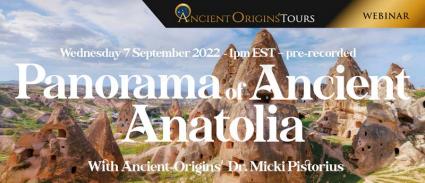
We present a panorama of the most interesting sites and history of Ancient Eastern and Central Anatolia or Turkey in this pre-recorded webinar.
Istanbul: A city of magic, mystery, strategic geographical importance, and historic consequence. Sultanahmet Square is our first point of departure. The hippodrome, a horse racing stadium was built in 203 AD by the Emperor Septimius Severus, when Istanbul was still Byzantium. Nowadays the site of the hippodrome forms a central pedestrian square and the ruins of the grand stand as well as the Serpent Column, Obelisk of Theodosius and the Walled Obelisk still stand sentinel to an ancient era. Below the square are several cisterns, including the Basilica Cistern. The square is flanked by the Sultan Ahmet or Blue Mosque, and the Hagia Sophia.
Centuries before Versailles, Buckingham Palace and the Kremlin Palace, on the shore of the Golden Horn, there rose a palace of such splendour, called Topkapi, where Ottoman sultans lived in lavish luxury, entertained kings, princes and foreign dignitaries, hoarded and displayed their riches and treasures and kept a harem of 1,000 concubines.
The sun has set on Istanbul and the focus moves to eastern Turkey to visit one of the most iconic sunset locations in the world, Mount Nemrut. Antiochus I Theos claimed himself a god, but there is no denying that his royal lineage was impressive. He was the creator of Mount Nemrut and the monumental pantheon of statues of himself and the gods on the mountain summit provide ring-side seats to history unfolding on the staged landscape before them. Gazing towards the east over centuries, the headstone of Antiochus would have seen the rise and fall of the Achaemenid Dynasty, as well as the Parthians; and gazing towards the west he would have seen the advance of Alexander the Great, the rivalry between the Seleucid and Orontid Dynasties for control of Armenia and finally the Roman legions marching into his land, swallowing his little Kingdom of Commagene.
The sun sets on Mount Nemrut and but dawns on the sunrise of history at Gobekli Tepe. In 1994, German archaeologist Klaus Schmidt discovered the site now called Göbekli Tepe, which was at first thought to be a temple. It was built, unquestionably, some 12,000 years ago. As archaeological work on the project continued, and the reliefs of the pillars are interpreted, it soon became obvious that Göbekli Tepe demonstrates uncanny astronomical alignments.
From the birth of civilization, to the birth city of Abraham, Harran was located on the caravan route that ran from Nineveh to Carchemish. In the 14th, 13th and 12th centuries BC, during the Hittite Period to Middle Assyrian Period, Harran and the surrounding region became the battlegrounds of the Hittites, the Mitannis and the Assyrians. For a few hundred years Harran, called Carrhae by the Romans was ruled by the Sassanid Empire and the Byzantine Empire intermittently until finally in 640 AD, Harran /Carrhae was conquered by the Muslim Arab General 'Iyāḍ b. Ghanm.
Not far from Harran lies Tas Tepeler. In 1997, the discovery of Karahan Tepe, revealed a structure similar to Göbekli Tepe, but perhaps even older. What is more, unlike Göbekli Tepe, it appears to be both ceremonial and a settlement. Now there are 12 other sites in the vicinity that demand the attention of the Turkish Ministry of Culture and Tourism. Hence the name, Taş Tepeler, or “Stone Hills.”
Old Edessa lies concealed by modern Şanlıurfa. Long before the city became Edessa, it was the Neolithic settlement of Urfa, with Balıklıgöl, a pool in the center of the town. The Urfa Man or Balıklıgöl statue, recognized as the oldest naturalistic life-sized sculpture of a human, was discovered here. Balıklıgöl is also called the Pool of Abraham, the site of the Jewish and Islamic traditions’ legendary clash between Nimrod and Abraham. Edessa was a crusader stronghold before it capitulated in 1146 and became a catalyst for the Second Crusade.
The name ‘Phrygia’ is usually associated with Alexander the Great cutting the famous Gordion Knot; as well as King Midas, the tragic greedy king, who touched his daughter and turned her into gold. But there was a historical King Midas. Does the Tomb of Midas hold the body of his father?
Tainted by regicide, usurped, regained, inspired by gods and goddesses and even cursed, the royal bloodline of the Bronze Age Hittites flowed through the plains of Anatolia, as the kings expanded and contracted the borders of their mighty empire, from their capital at Hattusa.
